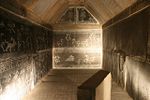
Luoyang Ancient Tombs Museum
Encyclopedia

Pinyin
Pinyin is the official system to transcribe Chinese characters into the Roman alphabet in China, Malaysia, Singapore and Taiwan. It is also often used to teach Mandarin Chinese and spell Chinese names in foreign publications and used as an input method to enter Chinese characters into...
: Luoyang gumu bowuguan) is a museum presenting Chinese
China
Chinese civilization may refer to:* China for more general discussion of the country.* Chinese culture* Greater China, the transnational community of ethnic Chinese.* History of China* Sinosphere, the area historically affected by Chinese culture...
ancient tombs in Luoyang
Luoyang
Luoyang is a prefecture-level city in western Henan province of Central China. It borders the provincial capital of Zhengzhou to the east, Pingdingshan to the southeast, Nanyang to the south, Sanmenxia to the west, Jiyuan to the north, and Jiaozuo to the northeast.Situated on the central plain of...
, in the Henan
Henan
Henan , is a province of the People's Republic of China, located in the central part of the country. Its one-character abbreviation is "豫" , named after Yuzhou , a Han Dynasty state that included parts of Henan...
province of China
China
Chinese civilization may refer to:* China for more general discussion of the country.* Chinese culture* Greater China, the transnational community of ethnic Chinese.* History of China* Sinosphere, the area historically affected by Chinese culture...
.
The Museum was established in 1984 and opened to the public in 1987. It is located on Mang Hill (邙山; pinyin: Mangshan), in the eastern side of Zhongtou Village, about 10 km (6.2 mi) north of Luoyang City. The site occupies 3 hectares. Mangshan, where the museum is located, is a hill about 300m above sea level that was historically a burial ground.
Exhibits
The museum comprises two parts: an underground and an above ground sections. The above ground part contains a HanHan Dynasty
The Han Dynasty was the second imperial dynasty of China, preceded by the Qin Dynasty and succeeded by the Three Kingdoms . It was founded by the rebel leader Liu Bang, known posthumously as Emperor Gaozu of Han. It was briefly interrupted by the Xin Dynasty of the former regent Wang Mang...
-style gate and several halls. Tomb models from the Stone Age to the Han Dynasty, restored funerary objects and funeral rituals are displayed in the eastern hall.
The underground section is a tomb groups site which is about 7 meters underground and contains 22 tombs from Henan province. It is divided into three halls: the hall of Wei
Northern Wei
The Northern Wei Dynasty , also known as the Tuoba Wei , Later Wei , or Yuan Wei , was a dynasty which ruled northern China from 386 to 534 . It has been described as "part of an era of political turbulence and intense social and cultural change"...
and Jin dynasties, the hall of Western Han and Eastern Han dynasties, and the hall of Tang
Tang Dynasty
The Tang Dynasty was an imperial dynasty of China preceded by the Sui Dynasty and followed by the Five Dynasties and Ten Kingdoms Period. It was founded by the Li family, who seized power during the decline and collapse of the Sui Empire...
and Song
Song Dynasty
The Song Dynasty was a ruling dynasty in China between 960 and 1279; it succeeded the Five Dynasties and Ten Kingdoms Period, and was followed by the Yuan Dynasty. It was the first government in world history to issue banknotes or paper money, and the first Chinese government to establish a...
dynasties.
The tomb of Emperor Xuanwu of Northern Wei
Emperor Xuanwu of Northern Wei
Tuoba Ke , later Yuan Ke was known as Emperor Xuanwu of Northern Wei during the Chinese/Xianbei dynasty Northern Wei....
(483-515) is part of the Museum. Luoyang was the capital of the Northern Wei Dynasty from 493 to 534.

